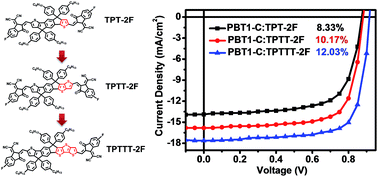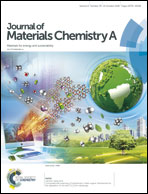Extension of indacenodithiophene backbone conjugation enables efficient asymmetric A–D–A type non-fullerene acceptors†
Abstract
A novel strategy involving judiciously fusing one thiophene/thieno[3,2-b]thiophene on only one side of an indacenodithiophene (IDT) unit to extend IDT backbone conjugation was developed, and three A–D–A type non-fullerene small molecules (TPT-2F, TPTT-2F, and TPTTT-2F) were designed and synthesized to investigate the influence of the extent of IDT core conjugation on their photovoltaic properties. Extending the IDT core conjugation could broaden absorption, upshift the lowest unoccupied molecular orbital (LUMO) energy level, enhance electron mobility, and increase intermolecular π–π stacking. When these three non-fullerene acceptors were applied in organic solar cells (OSCs), simultaneous enhancement of the open-circuit voltage (Voc), short-circuit current (Jsc), and fill factor (FF) was obtained, with the degree of enhancement following the order TPT-2F < TPTT-2F < TPTTT-2F. As a result, the TPTTT-2F based OSCs yielded a high PCE of 12.03%. To the best of our knowledge, the PCE of 12.03% is among the highest values for asymmetric non-fullerene acceptor based OSCs so far. These results demonstrate that extending the conjugation of the IDT core is an effective approach to design highly efficient asymmetric non-fullerene acceptors.



 Please wait while we load your content...
Please wait while we load your content...